Commission, July 25, 2016, No M.7927
EUROPEAN COMMISSION
Judgment
EPH / ENEL / SE
Dear Sir/Madam,
Subject: Case M.7927 - EPH / ENEL / SE
Commission decision pursuant to Article 6(1)(b) of Council Regulation No 139/2004 (1) and Article 57 of the Agreement on the European Economic Area (2)
(1) On 20 June 2016, the European Commission ("the Commission") received notification of a proposed concentration pursuant to Article 4 of the Merger Regulation by which the undertakings Energetický a průmyslový holding, a.s. ("EPH", the Czech Republic) and Enel SpA ("Enel", Italy) acquire, within the meaning of Article 3(1)(b) of the Merger Regulation, joint control over the undertaking Slovenske elektrarne, a.s. ("SE", Slovakia), by way of purchase of shares (the "proposed transaction"). (3) EPH and Enel are designated hereinafter as the "notifying parties"
1. THE PARTIES
(2) EPH is a utility company active in coal extraction; electricity generation, supply and distribution, as well as balancing and ancillary services; heat production and distribution; gas transmission, distribution, supply and storage. EPH is mainly active in the Czech Republic, Slovakia, Germany, Poland, Hungary, Italy and the UK.
(3) Enel is an integrated global player, active in electricity generation and gas distribution and supply.
(4) SE is active in electricity generation, wholesale and retail supply of electricity, as well as balancing and ancillary services in Slovakia. Pre-transaction SE was owned 66% by Enel and 34% by the Slovak State.
2. THE OPERATION AND THE CONCENTRATION
(5) Under the proposed transaction EPH will acquire a 50% shareholding in a newly established holding company to which the shareholding of Enel (66%) will be transferred before the closing of the proposed transaction. The remaining 34% in SE will continue to be held by the Slovak State. […] EPH will acquire joint control over SE with Enel. In light of the above, the transaction constitutes a concentration pursuant to Article 3(1)(b) of the Merger Regulation.
3. UNION DIMENSION
(6) The undertakings concerned have a combined aggregate world-wide turnover of more than EUR 5 000 million (4) [EPH: EUR […]; Enel: EUR 73 328 million]. Each of at least two of the undertakings concerned has a EU-wide turnover in excess of EUR 250 million [EPH: EUR […]; Enel: EUR […]], but they do not achieve more than two-thirds of their aggregate EU-wide turnover within one and the same Member State. The notified concentration therefore has an EU dimension within the meaning of Article 1(2) of the Merger Regulation.
4. RELEVANT MARKETS
(7) The notifying parties' activities overlap in the generation and wholesale supply of electricity, retail supply of electricity, and balancing and ancillary services in Slovakia. EPH, via SSE (5), is also active on the market for distribution of electricity.
(8) With respect to gas, the notifying parties are active in the retail supply of gas. EPH is also active on the market for distribution of gas.
4.1. Relevant product markets
4.1.1. Generation and wholesale supply of electricity
(9) The market for generation and wholesale supply of electricity comprises electricity generated in power stations, traded on the wholesale market (through bilateral agreements, regulated market places and power exchanges) as well as electricity physically imported via interconnectors. (6)
(10) In previous decisions, the Commission has taken the view (7) that the generation and wholesale supply of electricity are considered one single relevant product market because generation of electricity is not a market activity as long as the electricity is not sold.
(11) In line with the Commission's decisional practice, the notifying parties submit that the generation and wholesale supply of electricity constitutes a separate relevant market.
(12) The Commission is of the view that the market definition adopted in its past decisions should be retained for the purpose of the present case.
4.1.2. Retail supply of electricity
(13) The retail supply of electricity encompasses the overall sale of electricity to final customers.
(14) In previous decisions, the Commission identified two different product markets for the retail supply of electricity based on customer size: (i) the market for retail supply of electricity to large industrial customers that are connected to the high and medium voltage grid ('half-hourly metered') and (ii) the market for retail supply of electricity to small industrial and residential customers that are connected to the low voltage grid. (8) Customers were differentiated by whether they were measured on a continuous basis or not, as this highlighted the different purchasing power of clients.
4.1.2.1. The notifying parties' view
(15) The notifying parties submit that the relevant product markets for the retail supply of electricity in Slovakia are: (i) retail supply of electricity to customers connected to the Transmission System Operator (TSO) and (ii) retail supply of electricity to customers connected to the Distribution System Operator (DSO).
(16) The notifying parties further submit that the latter DSO cohort can be further segmented into: (i) retail supply to large industrial customers, that is customers with consumption greater than 1 GWh per annum and (ii) retail supply to small and medium industrial customers and households, that is customers with consumption lower than 1 GWh per annum.
4.1.2.2. The Commission's assessment
(17) Although currently in Slovakia customer consumption is measured on a '15-minute interval' meter reading on all levels of the grid (9), the Commission takes the view that the difference of the market conditions (with regard to the way of purchase, the amount of electricity purchased, the necessity of high security of supply, etc.) are such that it justifies the distinction of the end-users connected to the transmission system on one hand and to the distribution system on the other.
(18) The rationale underlying the further sub-segmentation of the market for retail supply of end-customers connected to the distribution system is that customers with yearly consumption above 1 GWh mostly procure and supply electricity through tenders so that the price and other commercial terms are negotiated individually, whereas customers with consumption below 1 GWh are usually supplied on the basis of the typical off-take diagram and the prices are based either on the suppliers’ price list or are set by the regulator (prices for households and small industrial consumers). The market for retail supply of electricity to customers with consumption below 1 GWh per annum could be further segmented depending on whether the regulated price cap applies to the customer or not. (10)
(19) For the purpose of the assessment of the proposed transaction the Commission considers that the exact product market definition can be left open as the proposed transaction does not raise serious doubts as to its compatibility with the internal market under any plausible product market definition.
4.1.3. Transportation of electricity
(20) TSOs operate and manage interconnected high-voltage grids thus providing electricity transportation services to electricity producers with a view to supplying distributors as well as large industrial (final) customers. DSOs comprise the operation and management of lower voltage grids thus providing electricity transportation services to distributors for the delivery of electricity to final customers.
(21) In previous decisions, the Commission identified two separate markets for the transportation of electricity: transmission and distribution. (11)
(22) In line with the Commission's decisional practice the notifying parties submit that the distribution of electricity constitutes a separate relevant product market.
(23) The Commission is of the view that the market definition adopted in its past decisions should be retained for the purpose of the present case.
4.1.4. Balancing and ancillary services
(24) Balancing and ancillary services can be defined as services consisting in maintaining the tension in the grid within a very narrow bandwidth. On the market for the provision of these services, transmission system operators ("TSOs") purchase electricity, using balancing exchange or bilaterally, in order to cover deviations between production and consumption within their relevant control areas. (12)
(25) In past decisions, the Commission has taken the view that a separate product market exists for balancing and ancillary services. This is due to the fact that this service cannot easily be replaced by other electricity suppliers on the wholesale market.
(26) In line with the Commission's decisional practice, the notifying parties submit that balancing and ancillary services constitute a separate relevant product market.
(27) The Commission is of the view that the market definition adopted in its past decisions should be retained for the purpose of the present case.
4.1.5. Transportation of gas
(28) On the market for distribution of gas distribution system operators ("DSOs") offer gas transport services to distributors via low pressure systems. (13)
(29) In previous decisions, the Commission has distinguished between (i) gas transmission (via high pressure systems) and (ii) gas distribution (via medium/low pressure systems).
(30) In line with the Commission's decisional practice, the notifying parties submit that the distribution of gas constitutes a separate relevant product market.
(31) The Commission is of the view that the market definition adopted in its past decisions should be retained for the purpose of the present case.
4.1.6. Retail supply of gas
4.1.6.1. The notifying parties' view
(32) The notifying parties submit that the retail supply of gas constitutes a separate relevant market which can be further segmented with regard to the customers to (i) supply of gas to dealers (including the local distribution companies); (ii) supply of gas to gas- powered electricity plants; (iii) supply of gas to large industrial customers; (iv) supply of gas to medium and small industrial customers and (v) supply of gas to household customers.
4.1.6.2. The Commission's view
(33) In previous decisions, the Commission has generally distinguished between the following types of gas supplies: (i) the supply of gas to gas-fired electricity plants (14); (ii) the supply of gas to large industrial customers (15), (iii) the supply of gas to small customers. (16) The last category could be further divided between (a) commercial customers and (b) households. (17) This product market definition is retained for the present case.
4.2. Relevant geographic markets
4.2.1. Generation and wholesale supply of electricity
(34) In previous decisions, the Commission has generally (18) considered this market to be national. (19) The notifying parties agree with this decisional practice. The Commission acknowledges that the high interconnection capacity of Slovakia and the amount of electricity imported and exported might indicate that the market for generation and wholesale supply of electricity might be wider than national. The Commission however considers for the purpose of the present case that the exact geographic market definition can be left open, as even on the narrowest plausible market (that is national), the proposed transaction does not raise serious doubts as to its compatibility with the internal market.
4.2.2. Retail supply of electricity
(35) In previous decisions, the Commission has considered this market to be national in scope for large industrial customers, provided that the market is fully liberalised and if the conditions of competition are found to be uniform throughout the relevant territory. (20) As for end-customers connected to the distribution system, the Commission has generally considered the geographic market to be national. The notifying parties agree with this decisional practice. The Commission, accordingly, considers the market for retail supply of electricity to end-customers connected to the transmission and the distribution system to be national in scope, encompassing the territory of Slovakia in the present case.
4.2.3. Distribution of electricity
(36) In previous decisions, the Commission considered that electricity distribution can be considered grid-wide in scope. (21) In the case where interconnection capacities create constraints, the relevant market is not defined beyond national borders. (22) The notifying parties agree with this decisional practice. The Commission therefore considers that market is limited to the distribution grid in the present case.
4.2.4. Balancing and ancillary services
(37) In previous decisions, the Commission has considered this market to be at most national in scope but potentially being regional or limited to the relevant TSO's control area. (23) The notifying parties submit that the market is national in scope. For the present case, the Commission takes the view that the market is national in scope.
4.2.5. Distribution of gas
(38) In line with its previous decisions, the Commission considers that the region covered by the physical infrastructure grid constitutes the narrowest possible delineation of the geographic market. (24) The notifying parties agree with this decisional practice. The Commission considers that geographic market definition should be retained for the present case.
4.2.6. Retail supply of gas
(39) In previous decisions, the Commission has considered this market to be not wider than national in scope, whilst also considering a regional delineation depending on the specific Member State. (25) The notifying parties submit that the market is not wider than national in scope. The Commission considers that the exact geographic market definition can be left open as the concentration does not raise serious doubts as to its compatibility with the internal market under any geographic market definition.
5. COMPETITIVE ASSESSMENT
5.1. Non-coordinated horizontal effects
(40) The proposed transaction will give rise to the following horizontally affected markets in Slovakia: (1) generation and wholesale supply of electricity; (2) retail supply of electricity to end-customers connected to the distribution system and (3) balancing and ancillary services. The market for retail supply of electricity to end-customers connected to the distribution system might be further segmented with regard to (i) large industrial customers and (ii) small and medium industrial customers and households.
5.1.1. Generation and wholesale supply of electricity
5.1.1.1. The notifying parties' view
(41) The notifying parties submit that the proposed transaction will not bring about a significant structural change in the market, given that EPH only has marginal activities on the market for generation and wholesale supply of electricity in Slovakia, and that therefore it would not result in a significant impediment to effective competition.
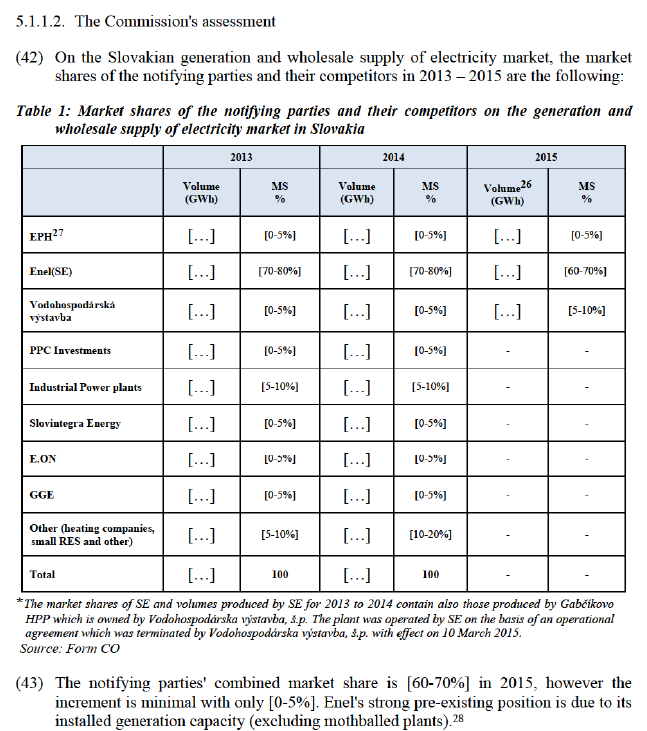
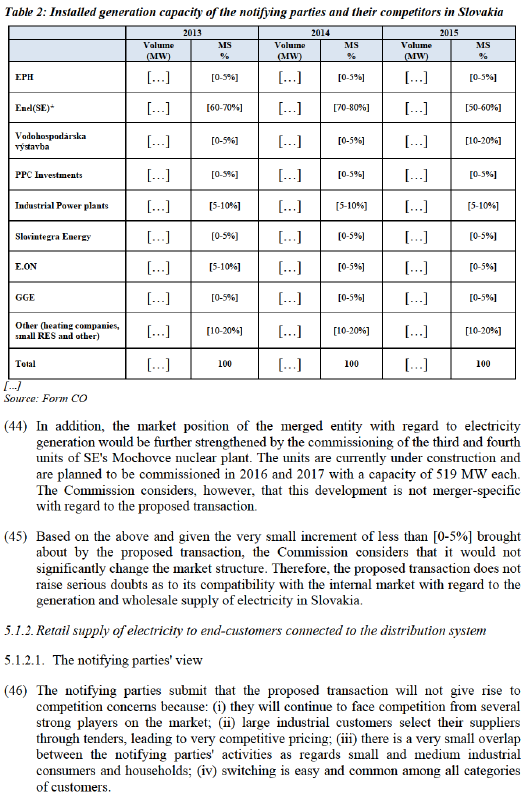
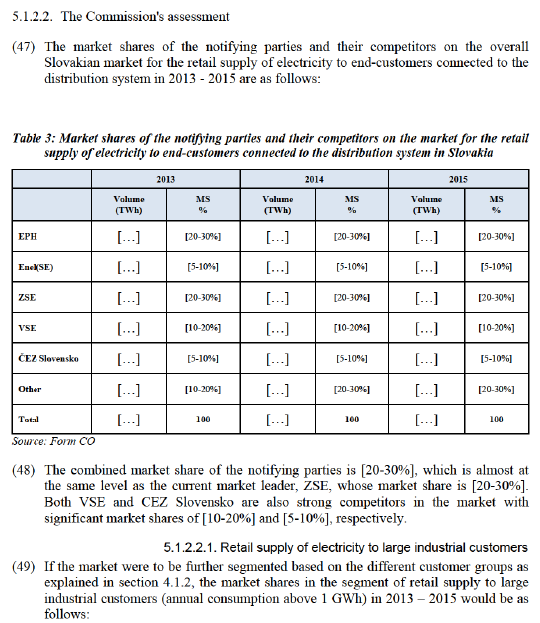
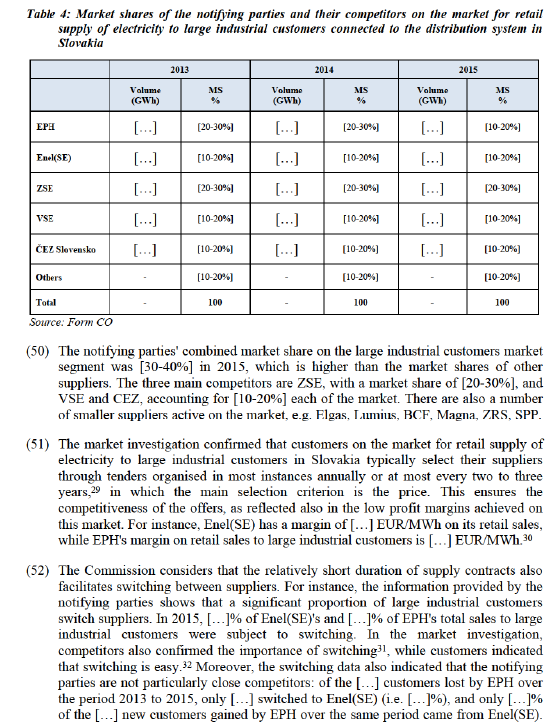
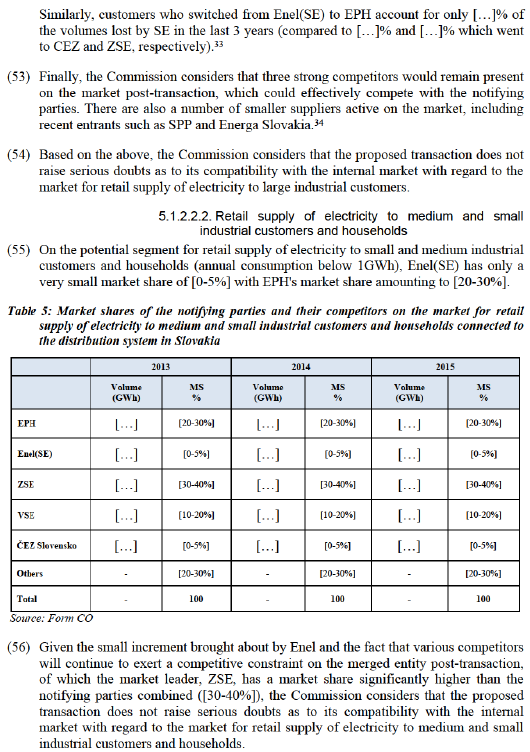
(57) If this market were to be further segmented based on non-regulated (medium industrial customers (35)) and regulated prices (small industrial customers and households (36)), the retail supply of electricity to medium industrial customers would not constitute an affected market. (37)
(58) As regards the retail supply of electricity to small industrial customers and households, the notifying parties have a combined market share of [20-30%]% with an overlap of less than [0-5%]. Given the insignificant increment brought about by Enel(SE) and the fact that there are numerous competitors remaining post-transaction, of which at least one – ZSE – has a market share higher than the merged entity ([30- 40%]), the Commission considers that the proposed transaction does not raise serious doubts as to its compatibility with the internal market with regard to the retail supply of electricity to small industrial customers and households with regulated prices.
5.1.2.2.3. Conclusion on the market for retail supply of electricity to end-customers connected to the distribution system
(59) Based on the above, the Commission considers that the proposed transaction does not raise serious doubts as to its compatibility with the internal market with regard to the retail supply of electricity to end-customers connected to the distribution system or any of its sub-markets.
5.1.3. Balancing and ancillary services
5.1.3.1. The notifying parties' view
(60) The notifying parties submit that the proposed transaction will not give rise to anti- competitive effects, in light of their limited overlap, the fact that the TSO organises tenders for the various services, and the existence of sound competition on the market for balancing and ancillary services.
5.1.3.2. The Commission's assessment
(61) The notifying parties' market share on the market for balancing and ancillary services in Slovakia in 2013 – 2015 are the following:
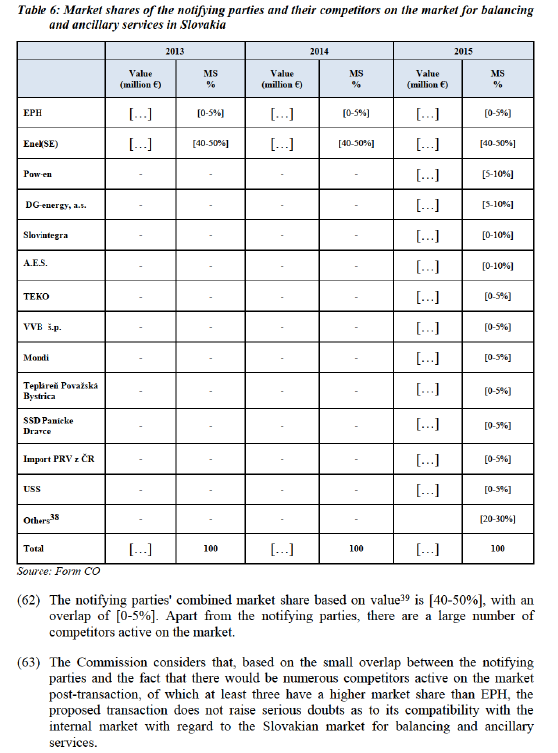
5.2. Non-horizontal effects
(64) The proposed transaction will give rise to vertically affected markets in Slovakia with regard to: (1) the generation and wholesale supply of electricity (upstream) and the retail supply of electricity to end-customers connected to the distribution system (downstream), (2) the distribution of electricity (upstream) and the retail supply of electricity to end-customers connected to the distribution system (downstream) in Slovakia, and (3) the distribution of gas (upstream) and the retail supply of gas (downstream) in Slovakia.
5.2.1. Generation and wholesale supply of electricity - retail supply of electricity to end- customers connected to the distribution system
5.2.1.1. The notifying parties' view
(65) The notifying parties submit that they would not be able to foreclose their downstream competitors' access to electricity (by limiting supplies or raising prices on the wholesale market) because: (i) Slovakia's interconnection capacity with surrounding countries allows sufficient volumes to be imported to cover domestic demand; (ii) there is a high level of liquidity and competition on the wholesale market as a result of the market coupling between the Czech Republic, Slovakia, Hungary and Romania; (iii) foreclosure would not be profitable as wholesale margins are much higher than margins on retail sales.
5.2.1.2. The Commission's assessment
(66) The Commission has analysed whether, post-transaction, the merged entity would have the ability and incentive to foreclose access to electricity to competitors on the downstream retail market.
(67) On the market for generation and wholesale supply of electricity, in 2015 the notifying parties had a combined market share of [60-70%] with an increment of [0-5%] brought about by EPH. In 2015 Enel(SE) had [50-60%] of the installed generation capacity in Slovakia ([60-70%] when mothballed plants are excluded), and it was an important supplier of electricity to its competitors on the retail market. (40) EPH owns less than [0-5%] of the total installed capacity in Slovakia. Thus, the merged entity's position on the generation and wholesale supply market, and its ability to (partially) foreclose access to electricity to its downstream rivals (e.g. by increasing its wholesale prices to its rivals), will not be materially different from the one Enel(SE) has today.
(68) Moreover, the Commission considers that SE will not have an ability to foreclose access to electricity to competitors on the downstream retail market. Slovakia is connected to the Czech Republic (CZ), Poland (PL), Ukraine (UA) and Hungary (HU). While the Slovak market is, in general, balanced (net imports were only 2 388 GWh in 2015), large volumes of electricity flow into the country (primarily from the Czech Republic and Poland), and are further exported (to Hungary, where prices are higher). In 2015, total physical imports were of 14 999 GWh, which represents 50% of the total electricity consumed in Slovakia (29 579 GWh). (41) The total import capacity through the three interconnectors was approximately 3 200 MW in 2015 (28 TWh), (42) i.e. around [70-80%] of SE's installed capacity but about […] more than what SE generated in 2015. (43)
(69) Furthermore, the Slovak wholesale electricity market is integrated with that of the Czech Republic, Hungary and Romania, which increases the liquidity of the market and the efficiency of cross-border capacity allocation. Congestion on the CZ-SK interconnector generally occurs during the maintenance period (less than 10% of hours); otherwise, the markets are coupled and the prices on the Czech and Slovak markets are the same. (44) The average spot price difference between the Czech Republic and Slovakia is less than €1/MWh. Congestion on the SK-HU interconnector is more frequent, due to the higher price of electricity in the Hungarian and Eastern European markets, which results in large electricity flows from Slovakia to Hungary.
(70) The Commission also considers that on the rare occasions when congestion occurs on interconnectors, the reliability of cross-border supplies is not affected, as these are guaranteed under the power purchase agreements the retailer has with its foreign suppliers. (45)
(71) Thus, even if the merged entity were to restrict its supplies of electricity to downstream rivals, these would be able to import electricity from abroad, and the price of imported electricity would act as a cap on the price the merged entity could set for its competitors on the downstream retail market. Therefore, SE does not have - and will not acquire as a result of the proposed transaction - the ability to significantly raise its downstream rivals' costs.
(72) Furthermore, based on the evidence submitted by the notifying parties and that collected in the market investigation, the Commission considers that the incentives to engage in foreclosure are also limited, for the following reasons.
(73) First, SE already operates as a vertically integrated retail supplier with a market share of [20-30%] on the overall retail market (including all end-customers connected to the distribution system as well as customers directly connected to the transmission system (46)). EPH accounts for [10-20%] of retail sales. While the relevant downstream market affected by the proposed transaction is that of retail supply to end-customers connected to the distribution system, (47) the notifying parties' shares of overall downstream sales are more relevant for assessing their potential incentives to engage in input foreclosure because it is not possible to discriminate between downstream users of electricity (as explained further in the following paragraph). In this respect, the Commission takes into account the fact that EPH does not contribute its downstream business to the joint venture. Therefore, only EPH may possibly have an incentive to increase the merged entity’s prices charged to its downstream rivals, whereas Enel's incentives would not be different from the ones it has today.
(74) Second, SE (or any wholesale supplier) is not able to determine or control the identity or nationality of the end buyer of the electricity it sells on the wholesale market. For instance, even if SE decided to sell part of its production abroad, e.g. in Hungary or the Czech Republic, Slovak suppliers would be able to buy electricity in Hungary or the Czech Republic and export it back to Slovakia. (48) Thus, it would not be able to restrict its supplies or otherwise increase the prices to its downstream rivals on the Slovak market without also restricting its supplies or otherwise increasing the prices everywhere in the region. This implies that any input foreclosure strategy would have a significant impact on the merged entity’s sales on the wholesale markets.
(75) Third, the merged entity has a much stronger incentive to maximise its wholesale supplies rather than its retail supplies, as currently margins on the wholesale market (SE: […] EUR/MWh, EPH: […] EUR/MWh (49)) are much larger than on the downstream market (SE: […] EUR/MWh, EPH: […] EUR/MWh (50)).
(76) Overall therefore, the Commission considers that the merged entity does not have an incentive to engage in an input foreclosure strategy. As a result of such a strategy, the merged entity would most likely forego some profits upstream, without being able to increase their rivals’ costs significantly. Moreover, any uncertain and small increase in profits downstream would not benefit the merged entity but EPH only.
(77) On this basis, the Commission considers that the proposed transaction does not raise serious doubts as to its compatibility with the internal market stemming from the vertical integration between the generation and retail supply of electricity.
5.2.2. Distribution of electricity - retail supply of electricity to end-customers connected to the distribution system
5.2.2.1. The notifying parties' view
(78) The notifying parties submit that the proposed transaction will not give rise to competition concerns stemming from the vertical relationship between the distribution and retail supply of electricity to end-customers because the market for electricity distribution is highly regulated.
5.2.2.2. The Commission's assessment
(79) EPH is currently active in the retail supply of electricity to end customers and, through SSE-Distribucia, in the distribution of electricity in the regions of Zilina, Banska Bystrica and a part of the Trencin region. SSE-Distribucia operates as the sole DSO in these areas on the basis of a license issued by the Slovak Regulatory Office for Network Industries. Thus, the existence of vertical integration between an upstream monopolist and a downstream supplier pre-dates the proposed transaction. Currently, any retailer supplying electricity to customers connected to the distribution system operated by SSE-Distribucia has no other choice but to request access to SSE- Distribucia’s distribution system on regulated distribution rates. Despite this monopoly position on an essential input, the market shares of EPH's downstream rivals have increased significantly from [20-30%] combined to [40-50%] combined over the period 2010-2015. (51) This could indicate that EPH had no ability and/or incentive to foreclose its downstream rivals. The proposed transaction will not change the merged entity’s ability and incentive in this respect.
(80) On this basis, the Commission considers that the proposed transaction does not raise serious doubts as to its compatibility with the internal market stemming from the vertical integration between the distribution and retail supply of electricity.
5.2.3. Distribution of gas – retail supply of gas
5.2.3.1. The notifying parties' view
(81) The notifying parties submit that the proposed transaction will not give rise to competition concerns stemming from the vertical relationship between the distribution and retail supply of gas to large and small industrial customers because the notifying parties only have a very small combined market share on the downstream market (of less than [0-5%]), and a large number of suppliers compete on this market, including SPP with a market share of [60-70%].
5.2.3.2. The Commission's assessment
(82) EPH controls the sole gas TSO in the Slovak Republic, through its indirect subsidiary Eustream, and one of the DSOs (having a share of [90-100%] of the gas distribution market in Slovakia), through its subsidiary SPP-Distribucia.
(83) EPH currently has activities on the market for the retail supply of gas, thus the existence of a vertical relationship pre-dates the proposed transaction. However, taking into account the marginal shares of both EPH and SE on the retail market resulting in a combined market share of less than [0-5%], (52) the proposed transaction is not likely to create competition concerns.
(84) On this basis, the Commission considers that the proposed transaction does not raise serious doubts as to its compatibility with the internal market stemming from the vertical integration between the distribution and retail supply of gas.
6. CONCLUSION
(85) For the above reasons, the European Commission has decided not to oppose the notified operation and to declare it compatible with the internal market and with the EEA Agreement. This decision is adopted in application of Article 6(1)(b) of the Merger Regulation and Article 57 of the EEA Agreement.
1 OJ L 24, 29.1.2004, p. 1 (the 'Merger Regulation'). With effect from 1 December 2009, the Treaty on the Functioning of the European Union ('TFEU') has introduced certain changes, such as the replacement of 'Community' by 'Union' and 'common market' by 'internal market'. The terminology of the TFEU will be used throughout this decision.
2 OJ L 1, 3.1.1994, p. 3 (the 'EEA Agreement').
3 Publication in the Official Journal of the European Union No C 235, 29.6.2016, p. 7
4 Turnover calculated in accordance with Article 5 of the Merger Regulation and the Commission Consolidated Jurisdictional Notice (OJ C 95, 16.4.2008, p. 1).
5 Stredoslovenská energetika, a.s.
6 COMP/M.6984 EPH / Stredoslovenska Energetika.
7 COMP/M.6984 EPH / Stredoslovenska Energetika; COMP/M.6540 Dong Energy Borkumriffgrund I Holdco / Boston Holding / Borkum Riffgrund I Offshore Windpark; COMP/M.6225 Molaris / Commerz Real / RWE / Amprion; COMP/M.5979 KGHM / Tauron Wytwarzanie / JV.
8 COMP/M.6984 EPH / Stredoslovenska Energetika; COMP/M.6225 Molaris / Commerz Real / RWE / Amprion; COMP/M.5979 KGHM / Tauron Wytwarzanie / JV.
9 However, not all customers are measured.
10 Price regulation applies to small and medium sized enterprises and households, i.e. end-customers with electricity consumption below 30 000 KWh.
11 COMP/M.6984 EPH / Stredoslovenska Energetika.
12 COMP/M.5979 KGHM / Tauron Wytwarzanie (2012); COMP/M.5827 Elia / IFM / 50Hertz (2010).
13 COMP/39.402 RWE Gas Foreclosure (2009).
14 COMP/M.4180 Gaz de France / Suez (2006); COMP/M.3696 E.On / MOL (2005).
15 COMP/M.4180 Gaz de France / Suez (2006).
16 COMP/39.315 ENI (2010); COMP/39.316 GDF gas foreclosure (2009); COMP/M.3440 EDP / GDP / ENI (2004); COMP/M.3696 E.On / MOL (2005); COMP/M.3868 DONG / Elsam / Energi E2 (2006).
17 COMP/M.4180 Gaz de France / Suez (2006); COMP/M.3696 E.On / MOL (2005).
18 The Commission has been considering whether the relevant geographic market is wider than national with regard to the Nordic countries given the full liberalisation of the markets in question and the common prices during the largest part of the year; the question was however left open. (COMP/M.3268 Sydkraft / Graninge (2003); COMP/M.3868 DONG / Elsam /Energi E2 (2006)) Similarly, the fact that certain Austrian electricity wholesalers sourced their electricity requirements to a significant extent from foreign producers hinted towards the existence of a relevant geographic market extending beyond Austria's national borders. (COMP/M.2947 Verbund / Energie Allianz (2003)).
19 COMP/M.6984 EPH / Stredoslovenska Energetika; COMP/M.6540 Dong Energy Borkumriffgrund I Holdco / Boston Holding / Borkum Riffgrund I Offshore Windpark; COMP/M.6225 Molaris / Commerz Real / RWE / Amprion; COMP/M.5979 KGHM / Tauron Wytwarzanie / JV; COMP/M.5827 Elia / IFM / 50Hertz.
20 COMP/M.6984 EPH / Stredoslovenska Energetika; COMP/M.6225 Molaris / Commerz Real / RWE / Amprion; COMP/M.5979 KGHM / Tauron Wytwarzanie / JV.
21 COMP/M.5827 Elia / IFM / 50Hertz; COMP/M.5467 RWE / Essent.
22 COMP/M.5827 Elia / IFM / 50Hertz.
23 COMP/M.5979 KGHM / Tauron Wytwarzanie / JV; COMP/M.5827 Elia / IFM / 50Hertz.
24 COMP/M.6984 EPH / Stredoslovenska Energetika; COMP/M.4180 Gaz de France / Suez.
25 COMP/M.5467 RWE Essent (2009); COMP/M.4890 Gaz de France / Suez (2006).
26 Parties could not precise volume data for competitors.
27 EPH is active on this market through its subsidiary Stredoslovenska energetika, a.s (« SSE »)
28 SE has three thermal, thrity-one hydro, two photovoltaic and two nuclear power plants.
29 From CO, paragraphs 225 and 226. Non-confidential version of replies to Q10 – Customers, question 6 and 7.
30 From CO, Table 11bis. SE could not provide margin data for seperate categories of retail customers.
31 VSE, ZSE and CEZ have an annual switching rate of (…)%, (…)% and (…)%, respectively.
32 Non-confidential version of replies to Q10 – Customers, question 12.
33 From CO, Annexes 20 and 26.
34 From CO, paragraph 450.
35 Customers with an annual consumption above 30 000 KWh but below 1 GWh.)
36 Customers with annual consumption below 30 000 KWh.
37 The notifying parties have a combined market share of [10-20%], with an overlap of [0-5%]
38 The notifying parties listed eight competitors with a market share of (0-5)% and six competitors with amarket share below (0-5)%.
39 The bnotifying parties are unable to provide data on volumes.
40 Form CO, Annex 23 ter.
41 Transmission system operator SEPS annual report 2015: http://www.sepsas.sk/seps/Dokumenty/RocenkySed/ROCENKA SED 2015.pdf
42 The import capacity is 1700 MW on the CZ – SK interconnector, 1300 MW on the HU – SK interconnector, 200 MW on the PL-SK interconnector.
43 Form CO, paragraph 265.
44 When the interconnector is congested, a Czech supplier which has a contract to supply electricity to a customer in Slovakia would not be able to export the electricity from the Czech Republic but would need to purchase it on the spot market in Slovakia (potentially at a higher price) in order to be able to fulfil its obligation towards its customer. The risk of congestion is borne by the supplier and is reflected in the price of forward contracts.
45 E-mails from competitors to the Commission's case team of 3 June 2016. Notifying parties' response to the Commission's questions of 6 June.
46 EPH is not active in the retail supply of electricity to customers connected to the transmission system.
47 SE market share [5-10%] EPH market share [20-30%] (see Section 5.1.2)..
48 Furthermore, as a result of the cross-border capacity netting mechanism, such cross-border trading would not necessarily result in increased physical flows, therefore it would not be constrained by interconnector congestion.
49 These figures include the bonus part of the feed-in tariffs received for producing electricity from renewable energy sources. Without this element, SE's and EPH's margins are […] EUR/MWh and […] EUR/MWh, respectively.
50 The figures reflect sales to all retail customers. SE cannot provide figures separated by type of customer (however SE only has minimal activities on the market for retail sales to small customers connected to the DSO); EPH's margin on its sales to large industrial customers connected to the DSO is […] EUR/MWh, and that on sales to small customers connected to the DSO is […] EUR/MWh.
51 Form CO, paragraph 343.
52 On the market for the retail supply of gas to large industrial customers, EPH has a market share of [0-5%] and SE a market share of [0-5%]. On the market for the retail supply of gas to small industrial customers, EPH has a market share of [0-5%] and SE a market share of [0-5%].